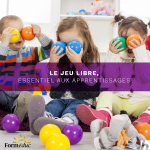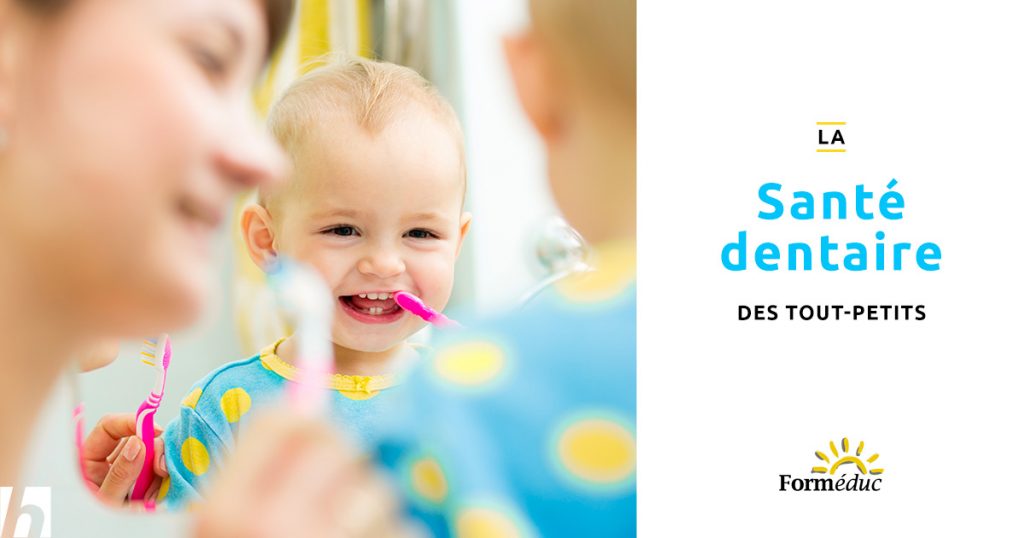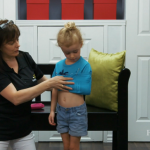

- 22 November 2020
- |
- Andrée Bouchard
At what age should we start brushing their teeth? Should we use toothpaste or just water? How can we encourage children to adopt healthy tooth-brushing habits? These are questions parents and educators often ask themselves.
The Canadian Dental Association recommends regular, thorough tooth brushing to remove bacteria that cause cavities, and plaque that leads to gum disease. Ideally, teeth should be brushed after every meal, as bacteria begin to attack teeth within minutes of eating. However, you should brush your teeth at least once a day, and always before going to bed.
It’s a good idea to clean baby’s mouth before the first tooth appears. The aim is to clean all parts of the gums and teeth.
Here are a few tips for cleaning the gums of teething babies:
- Make the baby comfortable.
- Make sure you can see into his mouth.
- Gently rub his gums and teeth with a baby brush or damp cloth.
- Don’t use toothpaste if he doesn’t yet have teeth.
- Avoid putting your baby to sleep with a bottle containing cow’s milk, formula, juice or sweetened liquids, to prevent early childhood caries (also known as baby bottle tooth decay).
As soon as the first tooth appears, it is suggested that the adult start brushing the baby’s teeth. It is recommended that the adult, not the child, brush the teeth of 0-3 year-olds, and that the adult help and supervise 3-6 year-olds during brushing.
Here are a few tips for brushing the teeth of infants and toddlers:
- Choose a small brush with a rounded or oval head.
- Use a toothbrush made of soft or extra-soft nylon.
- Use a manual or electric brush.
- Check that the toothbrush you choose is approved by Health Canada.
- Supervise children at all times during brushing, to make sure they don’t swallow the toothpaste.
- Help children complete their brushing properly.
- Change your toothbrush every three months or every season.
- Encourage children to brush their teeth at least twice a day.
- Choose toothpastes containing fluoride.
- Check that the product purchased is age-appropriate.
- Use a dab of fluoride toothpaste corresponding to a surface as thin as a sheet of paper from the appearance of the first tooth up to 12 months.
- Use fluoride toothpaste on an area the size of a grain of rice for children aged 12 months to 3 years.
- Use fluoride toothpaste on a pea-sized surface for children aged 3 and over.
At what age is the first visit to the dentist?
According to the Ordre des dentistes du Québec, the first visit to the dentist can be made within six months of the eruption of a child’s first teeth, or before the age of one.
It is strongly recommended not to go beyond the age of two for this first visit. Above all, don’t hesitate to take your child to the dentist, whatever his or her age, if you suspect a problem.
In Quebec, many dental services are covered up to the age of 10.
Here are some symptoms of tooth decay:
- No symptoms (during phase 1 of tooth decay, the person often feels no symptoms at all).
- Unpleasant sensation to cold, heat, sugar and pressure.
- Sensation of sharp, continuous pain.
- Presence of an abscess.
How to care for your toothbrush
Rinse the toothbrush and leave it to air dry, head up, avoiding contact with other toothbrushes to prevent the spread of germs.
Replace toothbrush when bristles have curled, or every month if necessary.
A healthy, varied and balanced diet, regular cleaning of gums and teeth, and regular visits to the dentist all contribute to a child’s oral health.
Sources
Ordre des dentistes du Québec: www.odq.qc.ca
Ordre des hygiénistes dentaires du Québec: www.ohdq.com
Canadian Dental Association: www.cda-adc.ca




